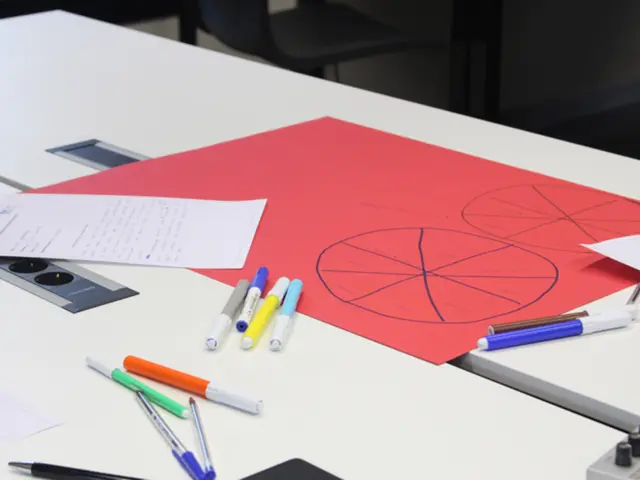Shining in the Architecture and Design Industry: Effective PR Strategies for Architects and Designers
Strategies for Architects and Designers: 7 Methods to Amplify Your Image and Win More Clients
A strong PR strategy is key to putting your fantastic projects in the limelight and getting noticed in the competitive architecture and design world. While a stellar portfolio and website are crucial, they work better when people already know you. That's where PR comes in, helping you achieve name recognition and establish your expertise.
PR not only showcases your projects, ideas, and achievements to new audiences but also expands your reputation, proves your authority, and attracts appropriate clients. To help architects and designers succeed in PR, follow these tactics, tailored to address the unique challenges and objectives within the industry.
1. Spin Your Tales: Create Media-Worthy Project Narratives
To pique the interest of industry publications and online platforms, focus on crafting compelling narratives that resonate with your ideal clients - both emotionally and intellectually.
Ponder over a sustainable office building project that reduces carbon footprint and features biophilic elements for the well-being of workers. You can frame it as a tale of environmental innovation, showcasing eco-friendliness and worker wellness.
Customize your pitch according to the platform's audience. If it's design-centric, highlight aesthetics and trendy design elements, while tech-oriented publications may favor insights into structural or engineering aspects. Align your stories with broader themes or events, such as releasing during Earth Week, to make your PR efforts more pertinent.
Use striking visuals, such as 3D animations or before-and-after renderings, to make your narrative even more engaging and memorable.
2. Harness Social Media: Amplify Your Expertise
Social media is a versatile platform for architects and designers to exhibit their knowledge and connect with diverse audiences.
Share high-quality images, 3D renderings, and project walkthroughs on platforms like Instagram. Alternatively, use LinkedIn to discuss design insights, trends, or collaborations. Engage your followers by responding to comments, participating in discussions, or tagging collaborators, and feature client testimonials or user-generated content to foster trust and accessibility.
3. Build Relationships: Network with Industry Insiders
Collaborating with influencers, bloggers, and journalists can significantly expand your reach and cultivate credibility. First, identify key players in your niche and engage genuinely with their content. Once you've established rapport, explore partnerships for guest blogging, interviews, or joint campaigns that showcase your expertise.
Partnering with a design influencer can help captivate their audience. Likewise, guest blogging for popular platforms or participating in industry podcasts further positions you as an authority. Strive to provide value in return by offering unique insights, exclusive content, or mutual promotion, fostering trust and amplifying your reputation.
4. Brand Consistently: Stay True to Your Identity
A cohesive branding strategy is crucial for architects and designers, encompassing everything from a proper visual identity (logos, color palettes, and fonts) to a consistent tone of voice and messaging. A modern architectural firm might adopt minimalist typography and a monochromatic palette to represent the fusion of simplicity and sophistication. While a design studio focused on eco-friendly projects might use earthy tones and organic shapes.
Staying consistent in messaging, from social media posts to project proposals, solidifies trust and reinforces your identity. Iconic firms, such as Zaha Hadid Architects and Studio McGee, maintain consistent visuals and messaging that align with their work and target audience.
5. Share Your Wisdom: Be a Thought Leader
Position yourself as an expert in the field by writing articles for trade publications, hosting webinars, and giving talks at industry events. Sharing your insights on topics like sustainable architecture or AI-driven design cements your reputation as a forward-thinker.
Pitch your ideas to global platforms like Architectural Digest, De Zeen, or niche magazines to widen your reach and solidify your status as an authority. Compelling photos, 3D renderings, or animations make your press releases or articles even more impactful.
6. Team Up: Collaborate with Like-Minded Professionals
Partnering with other experts, like interior designers, developers, or real estate agents, opens doors to new opportunities and broadens your network.
For example, a collaboration with a real estate agent to market luxury homes can result in cross-promotion and mutual client referrals. Collaborative projects display your ability to work with others, a selling point for future clients.
To find your collaborators, attend industry events, engage in online forums, or leverage social media connections. Nurturing strong working relationships involves transparent communication, mutual respect, and shared objectives. Through collaboration, you can elevate your brand and demonstrate the value of your expertise.
7. Get Out There: Utilize Event Participation to Boost Your PR
Participating in events like trade shows or design expos is a powerful PR tool. These gatherings provide a platform to showcase your work, mingle with industry peers, and meet potential clients. Hosting a booth at a design expo or presenting a project at a themed conference can position you as a leader in your field.
Events also offer direct access to media representatives, increasing the likelihood of press coverage. Prepare enticing visuals—photorealistic CGI—that capture attention, regardless of the project stage. Networking at these events allows you to form connections that can lead to collaborations and future projects. Whether attending or hosting, events offer unique opportunities to boost your reputation and expand your professional reach.
Enrich your architectural knowledge and elevate your PR game with our architecture rendering services. Contact us at ArchiCGI for photoreal 3D renderings, cutting-edge interactive solutions, and more!
Stacey Mur*Content Writer, Copywriter*
Stacey is a content writer and CG artist passionate about musicals, Star Wars, and art talk, with a proud Corgi parent.
- Leverage Technology: Showcase Your Work with Advanced VisualizationsStay ahead of the curve by embracing technologies like virtual reality (VR), augmented reality (AR), and artificial intelligence (AI) for innovative visualizations of your projects. Interactive 3D tours can intrigue potential clients, while AI-driven design tools enable you to create smart homes and integrated living spaces that cater to the modern lifestyle.
- Educate and Inspire: Offer Online Courses and Learning MaterialsPosition yourself as a thought leader in education and self-development by creating online courses or producing educational content on topics like interior-design principles, sustainable architecture, or 3D modeling. These resources not only demonstrate your expertise but also help others hone their skills, attracting a larger, appreciative audience.
- Connect with Financiers: Establish Relationships with Venture CapitalistsAs an entrepreneur in architecture and design, forging partnerships with venture capitalists can help you secure funding for groundbreaking projects. Align your ambitions with their investment interests by demonstrating a strong business plan, unique value proposition, and market potential.
- Diversify Your Portfolio: Explore Smart-Home Devices and the Internet of Things (IoT)Integrate smart-home devices and the Internet of Things (IoT) into your architectural designs to cater to growing user demands for increased home automation. These practical applications of technology can generate buzz, positioning you as a pioneer in the industry's evolution.
- Cultivate a Collaborative Environment: Foster a Culture of InnovationIncorporate open forums, brainstorming sessions, and creative workshops into your design processes to encourage collaboration, idea generation, and ongoing learning. This collaborative environment not only yields innovative designs but also reflects the values and ethos of your entrepreneurship.
- Stay Curious: Pursue Lifelong Learning to Adapt to the Rapidly Changing IndustryThe architecture and design industry is continually evolving. Stay on top of emerging trends, such as cutting-edge technology, alternative building materials, and green initiatives, to keep your work relevant and your clients satisfied. Whether through online education or attending conferences, never cease seeking knowledge and expanding your horizons.




